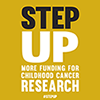Lung (Pulmonary) Health
The lungs are important organs responsible for supplying oxygen to the body and ridding it of carbon dioxide. Sometimes, treatments given for children’s cancer can cause lung damage. If you received any treatments that have the potential to cause lung problems, it is important to learn about the lungs and what you can do to keep them healthy.
In order for oxygen to reach the blood, it must move through tiny air sacs (alveoli) in the lungs and into tiny blood vessels (capillaries) that surround each air sac. When the air sacs become damaged or scarred, there is less area for oxygen to enter the bloodstream, causing less oxygen to reach the blood. This may cause a person to breathe fast in order to get enough oxygen, which can make someone feel short of breath. Other lung problems can be caused by inflammation (swelling) of the air passages in the lungs or increased mucous production as a result of irritation or infection. Symptoms can include cough, wheezing, chest pain, and shortness of breath.
Who is at Risk for Lung Problems?
If you received any of the following treatments during your cancer therapy, you may be at risk for developing lung problems:- Bleomycin
- Carmustine (also known as BCNU)
- Lomustine (also known as CCNU)
- Radiation to the chest (including mantle, mediastinal, or whole lung fields)
- Radiation to the abdomen (including whole abdomen or any upper abdominal field)
- Radiation to the spine in doses of 30 Gy (3000 cGy/rads) or higher
- Total body irradiation (TBI)
- Surgery to the chest or lung (this does NOT include surgery for placement of a central line, such as a Hickman, Broviac, Port-a-Cath or Mediport)
- Bone marrow transplant or stem cell transplant from a donor other than yourself (allogeneic transplant), if you then developed chronic graft versus host disease (chronic GVHD)
- Certain chemotherapy drugs known as anthracyclines, such as daunorubicin (Daunomycin®), doxorubicin (Adriamycin®), and idarubicin (Idamycin®) can damage the heart and may contribute to lung problems, especially if given in combination with bleomycin, BCNU, CCNU, and radiation treatment.
- Younger age at the time of cancer treatment
- A history of lung infections, asthma or other lung problems
- Tobacco use or exposure to second-hand smoke
Problems that may Develop
Problems can include scarring of the lungs (pulmonary fibrosis), repeated lung infections (such as chronic bronchitis or recurrent pneumonia), rupture of the tiny air sacs in the lungs, or thickening and blockage of air passages within the lungs (restrictive/obstructive lung disease).
Symptoms of Lung Damage
Symptoms may include shortness of breath, frequent coughing and/or wheezing, chest pain, and frequent lung infections, such as bronchitis or pneumonia. Becoming easily fatigued or short of breath during mild exercise (exercise intolerance) is sometimes an early symptom of lung damage.
Recommended Monitoring
- A yearly medical check-up is recommended.
- A chest X-ray and pulmonary function test (including DLCO and spirometry) may show lung problems that are not apparent during a check-up. For this reason, it is helpful to have these tests done at least once (at least two years after completing cancer treatment). Your healthcare provider can decide if further testing is needed based on these results.
- In some cases, your healthcare provider may recommend repeating the chest X-ray and pulmonary function test if you are scheduled for surgery that requires general anesthesia. This is done to check for changes in the lungs that could increase the risk of breathing problems during or after anesthesia.
Special Precautions
If you have had any of the treatments listed above you should:- Get the pneumococcal (pneumonia) vaccine.
- Get yearly influenza (flu) vaccines.
- Avoid SCUBA diving, unless you have undergone a thorough medical evaluation and received clearance from a diving medical specialist.
Preventing Lung Problems
- If you don’t smoke, dip, or chew tobacco, DON’T START.
- If you smoke or use tobacco, quitting is the most important thing you can do to maintain and improve your overall health.
- Avoid second-hand smoke.
- Get regular physical exercise.
- Avoid breathing toxic fumes from chemicals, solvents, and paints.
- Follow all safety precautions in your workplace, such as the use of protective ventilators in some work environments.
Help for Quitting Smoking
Your most important resources for quitting smoking are your family, friends, and your healthcare provider. Listed below are some additional sources of education and support:
American Cancer Society 1-800-ACS-2345
American Heart Association 1-800-AHA-USA1
American Lung Association 1-800-LUNG-USA
www.smokefree.gov
Provides support, tips, tools, and expert advice to help you or someone you love quit smoking.
www.cdc.gov/tobacco
The Center for Disease Control’s Tobacco Information and Prevention Source (TIPS) includes guides for quitting the tobacco habit.








